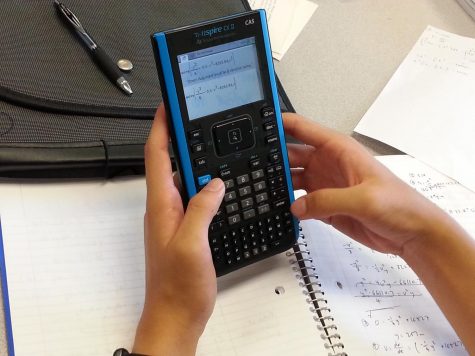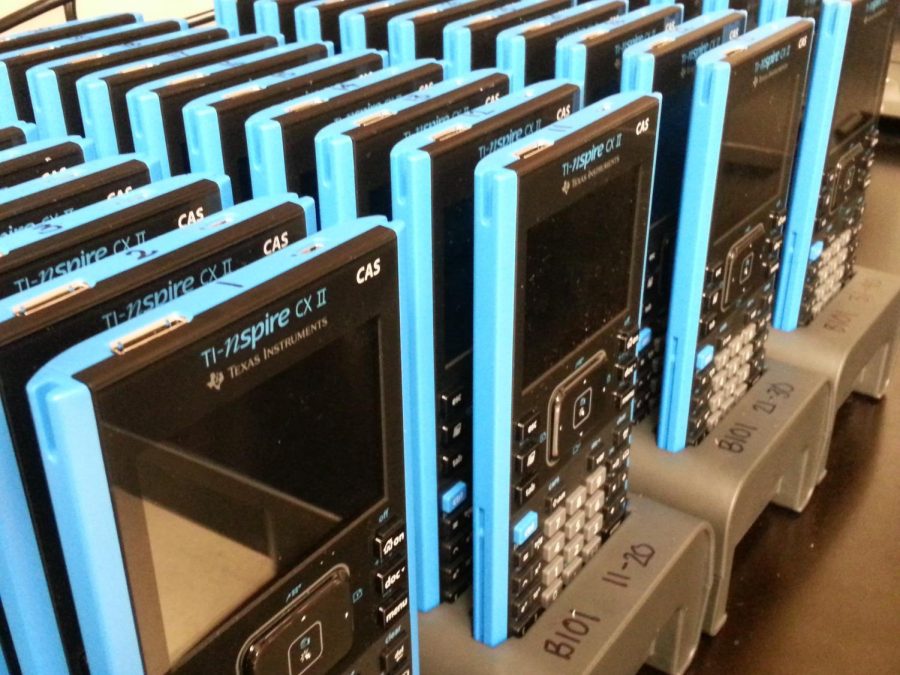AP Physics C stands to benefit from new TI-Nspires
Class set of graphing calculators purchased to thwart cheating in AP Physics C
The new class set of TI-Nspire graphing calculators stand in their chargers in AP Physics C teacher Jim Birdsong’s classroom. Photo by Alyssa Umino.
September 9, 2019
new class set of TI-Nspire graphing calculators may help prevent cheating in AP Physics C. According to Jim Birdsong, the AP Physics C teacher, the types of calculators needed in the course save every keystroke, so by using personal calculators, students were able to potentially share their test work. But with the new class set, which students are required to use on tests, Birdsong can administer every calculator himself.
“We can ask [students], yes, ‘Clear your memory,’” Birdsong said. “But you know, if that level of dishonesty exists, they’re not going to do that because we say so. So the initial guiding thing was to have a set that we can control and clear the memory [for] in between periods.”
Senior Audrey Cui, who took the course last year, recalls a “finals cheating scandal” where students were suspected of using their calculators to leak answers to students taking the final on a later day. Birdsong also confirms that there had been “some academic dishonesty issues at school for a while.” As a result, 40 TI-Nspires were purchased for the Physics C classroom in order to prevent this sort of cheating in the future.
“I think it’s a totally valid concern,” Cui said. “I know it’s a really common thing for people to compare answers with the people who have already taken the test to see how many they got right or wrong or whatever, but it seems like if people do that it’s really possible for people to cheat in the same way.”

However, Birdsong finds other benefits to this purchase as well. For example, having a set of TI-Nspires available in class allows students from all economic backgrounds to work with the same advantages.
“Some people come in with special programs that help them do certain problems faster, calculator program[s],” Birdsong said. “On the other end of things, some kids can’t afford a good calculator at all. We [live] in a very wealthy area, but there’s all [kinds] of people. One kid with a really awesome calculator competing with someone with a very basic one, it doesn’t make a fair playing field.”
Birdsong relates this to his own physics education, when he was taking a class in college. By saving up, he was able to buy a calculator far superior to what the rest of the class owned.
“[It was] totally unfair,” Birdsong said. “I had a big advantage. [It] should not have been allowed, but I got to — I was able to take advantage of it. I still had to know stuff, it just was faster.”
Junior Albert Xu, who is currently taking AP Physics C, acknowledges speed as another benefit of having the class set.
“If we didn’t have our [TI-Nspires], instead of solving a problem in, say, five minutes, it might take us an hour,” Xu said. “It’s just more efficient with the class set of calculators, otherwise what might be a simple problem would actually take an inappropriate amount of class time. [I’d] say the calculators are very crucial to the way the class moves, its pacing and the amount of stuff we learn.”
Birdsong agrees, pointing out that the exclusive use of TI-Nspires in class is helpful for keeping his lessons uniform.
“Having a unified calculator lets me give one set of instructions and one set of hints [to] help them do [a] particular assignment,” Birdsong said. “In the old days, I would have to have one [set of instructions] for every calculator that the kids used, and there’s probably four or five types. So having a class set allows me to be more efficient there.”

One concern about the TI-Nspires has been the cost of purchasing such a large set. A single TI-Nspire typically goes for upwards of $150, some even going as high as $180. With the class set comprising of 40 total calculators, this puts the cost at an estimated six to seven thousand dollars.
“I mean, the calculators are expensive, but if the school can afford a glass gym, I don’t see any reason why [they can’t] buy calculators,” Cui said.
Xu also voices some concern for the price, though he believes that the advantages of having a class set outweigh the financial aspect.
“I felt like a class set of [TI-]Nspires [was] a little expensive, but I do think it was worth it,” Xu said. “The TI-Nspires [allow] you to know less [calculus], which is more important for juniors who take the class, [because it] allows you [to] spend more of your resources and time on the concepts being taught in class rather than having to gain that previous knowledge before taking the course.”
In line with Xu’s opinion, Birdsong emphasizes the importance of physics over math.
“If someone’s going to miss a problem, I want it to be because they don’t understand physics, not because they don’t understand math,” Birdsong said. “So we’re getting closer to that goal with having [a class set]. We’ve been wanting [one] for years.”


















